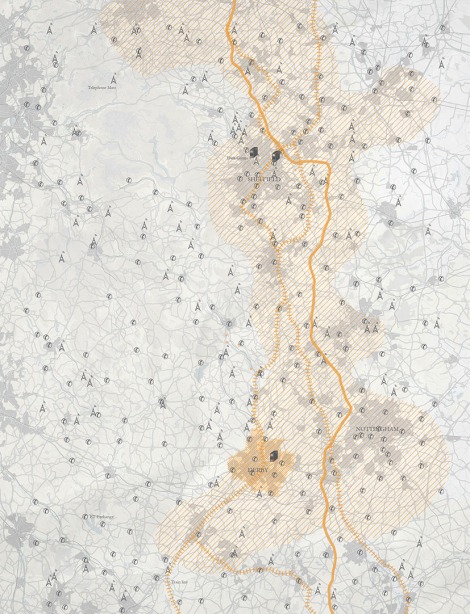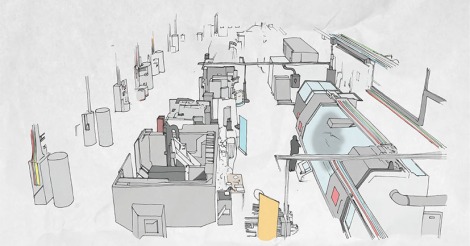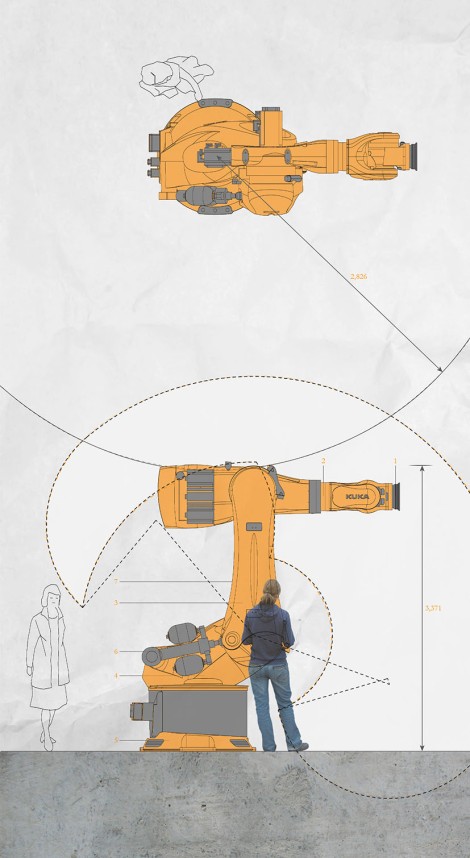Part I: Creating an Equal Opportunities Future for Start-Ups in an Automated Economic Climate
This short essay forms both mission statement and reflection upon the work undertaken while studying for the MArch in Architecture & Town and Regional Planning in Studio FutureWorks under the tutelage of Renata Tyszczuk and Julia Udall. Tapping into a long-running research interest of the intersection of technology, society and democracy, my work explored the specific thread of increasing automation and its effects on the unskilled and low skilled workers it threatens to replace.
This post, part 1, explores the economic and socio-technological context surrounding equality in work and disruptive technologies. Part 2, here, applies this research into an architectural proposal for an Automation Integration Centre (AIC) located in Catcliffe, near the Advanced Manufacturing park enterprise zone.

A manifesto for human-robotic relationships
The stimulus for this project emerged from an increasingly broad divide between the net income and economic opportunities between the richest 20% and others in the UK1. These are not new figures, the wage divide has been felt for many years, reaching a media head in the Occupy Movement in 20112. Within Catcliffe, near Rotherham in South Yorkshire, the development of the Advanced Manufacturing Park (AMP) near the site of the colliery and historic mining protests at Orgreave in 19843 has led to personal frustration at the continuing economic easing for large corporations through enterprise zone economic policies. These pockets of eased taxation pull corporations to specific areas, often on the fringes of existing urban areas.
While these zones had some success in spatially targeted fiscal incentives toward regeneration, particularly encouraging local industrial and commercial development, they had multiple identified failings4. The largest of these is a displacement effect, wherein almost half the activity recorded in zones had in fact merely relocated for taxation benefits. Despite these criticisms, these zones have re-emerged in recent years5 as a response to the 2008 international economic downturn.

Transportation and Communication in the Derwent Valley
The AMP, home to the Advanced Manufacturing Research Centre (AMRC)6, a collaboration between Boeing and the University of Sheffield, is situated at Waverley. The AMRC specialises in the use of robotics and automation in developing for high value markets with cutting edge machinery. Recently, a new state of the art Factory 20507 has opened for the centre, based upon a research paper8 advocating flexible, reconfigurable production lines to cater for a more bespoke, automated workflow. Membership of the AMRC reflects the cutting edge nature of the practice, with high entry fees and membership benefits catering to the biggest corporations in the world, such as Boeing (co-owners) and Rolls Royce. This exclusive cycle feeds the research benefits back to capitalist benefactors through the exploitation of enterprise zone tax relaxation whilst promoting an automation-heavy production model for maximum efficiency.

The future of the factory?
Therefore, in addition to large corporation shifting business location for tax benefits as oppose to increasing employment, improvements to automation and robotics technologies further infringe upon low skilled workers’ jobs. Current figures estimate that 47% of all jobs are at risk of automation within the next 20 years, with peaks of 87% (in furniture making) in high risk fields9. Francesca Bria, former Senior Project Lead at Nesta10 states that even today, the robot economy is a reality, robots are being introduced at 30,000 a year, while Amazon has 25,000 robots in their warehouses. Within two decades, automation threatens to evolve from its current iterative technology status to a ‘disruptive’ form, upsetting societal balance of employment, in workshops, offices, and on our roads. The potential impact of these ‘disruptive technologies’ can be read in more detail in a post by Julia Udall (2016)11.

Six Axis robots and their capabilities
In his series Robotic Nation, Marshall Brain12 argues that automation will lead to structural unemployment, and hence require a basic income guarantee. Recently, the Shadow Chancellor John McDonnell has hosted a series of panels13 exploring this policy pathway with multiple economists. Paul Mason14 argues that a radical reallocation of capital and debts could help advance upon the notion that free market capitalism is broken and captured by the hereditary elite.
Nick Srnicek15 meanwhile argues that another option to move forward is to accept the potential of automation and accept it into the economy. This poses the question: how do we prepare for a world full of automation?
Part 2, here, applies this research into an architectural proposal for an Automation Integration Centre (AIC) located in Catcliffe, near the Advanced Manufacturing park enterprise zone.
References
1 The Economist, 2016. British economy policy is not helping those at the bottom. The Economist. 15 July. Available at: <http://www.economist.com/blogs/freeexchange/2016/07/pointer-new-chancellor?fsrc=scn/tw/te/bl/ed/>
2 Occupy Wall Street <http://occupywallst.org/>
3 Conn, D., 2012. Miners’ strike: how the bloodiest battle became the ‘biggest frame-up. The Guardian. 22 November. Available at: <http://www.theguardian.com/politics/2012/nov/22/miners-strike-orgreave-bloodiest-battle>
4 Squires, G., and Hall, S., 2012. Lesson (un)learning in spatially targeted fiscal incentive policy: Enterprise Zones (England) and Empowerment Zones (United States). Land Use Policy 33(2013) pp.81-89.
See also: Butler, S., 1991. The Conceptual Evolution of Enterprise Zones in Green, R., ed., 1991. Enterprise Zones: New Directions in economic development. Newbury Park: Sage; and Department of the Environment, 1995. Final Evaluation of Enterprise Zones. London: Her Majesty’s Stationary Office.
5 Ward, M., 2016. Enterprise Zones. London: House of Commons Library. Available at: <http://researchbriefings.files.parliament.uk/documents/SN05942/SN05942.pdf>
6 The AMRC <http://www.amrc.co.uk/>
7 Factory 2050 <http://www.bondbryan.com/factory-2050>
8 Ridgway, K., Clegg, C.W., and Williams, D.J., 2013. The Factory of the Future. Foresight, Government Office for Science. Available at: <https://www.gov.uk/government/uploads/system/uploads/attachment_data/file/283903/ep29-factory-of-the-future.pdf>
9 Osborne, M.A., and Frey, C.B., 2013. The Future of Unemployment: How Susceptible are jobs to computerisation? Oxford Martin Programme on Technology and Employment. Available at: <http://www.oxfordmartin.ox.ac.uk/downloads/academic/future-of-employment.pdf>
10 Bria, F. Profile at Nesta. <http://www.nesta.org.uk/users/francesca-bria>
11 Udall, J., 2016. Energy, Disruptive Technologys. Stories of Change Future Works [blog] Available at: <https://storiesfutureworks.wordpress.com/2016/05/31/energy-disruptive-technologies/>
12 Brain, M. Robotic Nation. <http://www.marshallbrain.com/robotic-nation.htm>
13 McDonnell, J., 2015. New Economics 001: Technology and the Future World of Work Available at: <https://www.youtube.com/watch?v=jACOyOo9Yrs&sns=em>
14 Mason, P., 2016. Post-Capitalism: A Guide to Our Future. London: Penguin.
15 Srnicek, N., 2015. Inventing the Future: Postcapitalism and a World without Work. London: Verso.

Pingback: ‘Unlikely Professionals’ and the Economy of Automation, Part II | Future Works·